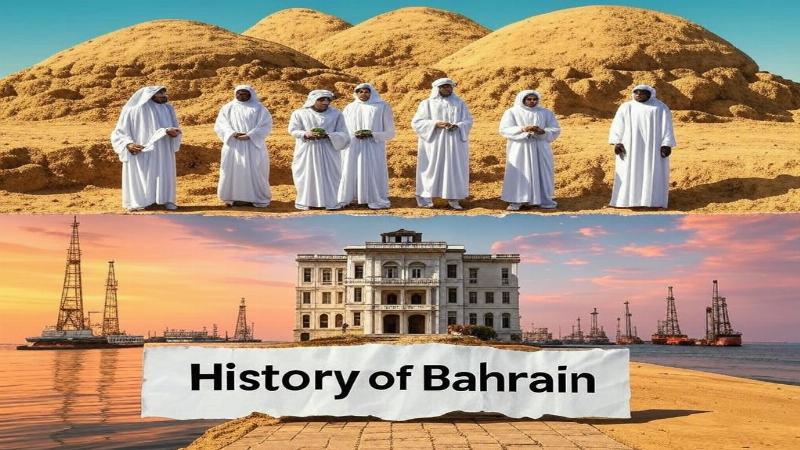Place for ads

Bahrain, a small archipelago in the Persian Gulf, is a nation where ancient roots and modern ambitions intertwine. Covering just 780 square kilometers, its 33 islands—dominated by the main island of Bahrain—lie east of Saudi Arabia, linked by a causeway. Known today for its skyscrapers and Formula 1 racing, Bahrain boasts a history stretching back over 4,000 years, shaped by trade, empires, and resilience. Often called the “Pearl of the Gulf,” its past is a blend of Mesopotamian glory, colonial struggles, and oil-driven transformation. In this article, we’ll explore Bahrain’s journey through time, tracing the milestones that define its enduring legacy.
Bahrain’s story begins in antiquity, with evidence of human presence dating to around 5000 BCE. Archaeological sites like Saar reveal Stone Age tools and settlements, suggesting early hunter-gatherers roamed its shores. By 3000 BCE, Bahrain emerged as Dilmun, a thriving trade hub mentioned in Sumerian texts as a land of immortality and wealth.
Dilmun’s strategic location linked Mesopotamia to the Indus Valley, trading copper, pearls, and dates. Burial mounds—over 170,000 dot the island—hint at a complex society, with artifacts like pottery and seals showing its reach. By 2000 BCE, Dilmun’s capital, near modern
Place for ads
Dilmun’s golden age waned by 1200 BCE, but Bahrain remained a prize. The Assyrians and Babylonians claimed it in the 7th and 6th centuries BCE, followed by the Achaemenid Persians around 540 BCE. Alexander the Great’s successors, the Seleucids, briefly held sway after 323 BCE, renaming it “Tylos” and noting its pearl fisheries.
Parthian and Sassanid Persians dominated from the 3rd century CE, fortifying Bahrain as a naval base. Christianity arrived by the 4th century—ruins of a Nestorian church near Samahij attest to this—before Islam swept in with the Arab conquests of 630 CE. The shift to Islam under the Umayyads tied Bahrain to the caliphate’s orbit.
The 9th century saw Bahrain flourish under the Abbasids, with Manama emerging as a port. The Qarmatians, a radical Ismaili sect, seized it in 899 CE, using it as a base to raid Baghdad and defy the caliphs. Their rule ended in 1076 when the Uyunids, a local Arab dynasty, restored order, building mosques and markets.
By the 13th century, the pearling industry boomed—Bahrain’s “white gold” adorned royals from India to Europe. The Salgharids and later the Hormuz Kingdom controlled it, but Portugal’s 1507 invasion marked a new era. The Portuguese held Bahrain until 1602, when Safavid Persia expelled them, cementing Shia influence.
Safavid Persia ruled Bahrain through the 17th and early 18th centuries, battling Ottoman incursions. By 1783, the Al Khalifa family—Sunni Bedouins from Qatar—conquered it, ousting Persian garrisons. Led by Ahmed Al Fateh, they made Bahrain their base, shifting the capital to Riffa, then Manama.
The Al Khalifa faced threats—Omani raids and Wahhabi incursions from Saudi Arabia—but solidified power with British help. Pearling remained king, employing thousands by the 19th century, while trade with India and Britain grew. This set the stage for colonial entanglement.
In 1820, Britain signed a treaty with the Al Khalifa, making Bahrain a protectorate to secure Gulf trade routes. The 1861 Perpetual Truce of Peace and Friendship deepened this bond, with Britain managing foreign affairs. Manama became a British hub, its naval base countering piracy and Ottoman ambitions.
The pearl trade peaked in the 1900s, but Japan’s cultured pearls crashed the market by the 1920s. Social tensions rose—Shia majority grievances against Sunni rulers flared in the 1921 Manama riots. Britain’s 1923 reforms curbed the Al Khalifa’s power, appointing Charles Belgrave as advisor to modernize governance.
In 1932, Bahrain struck oil—the first Gulf nation to do so—at Jebel Dukhan. The Bahrain Petroleum Company (BAPCO), backed by American firms, transformed the economy. Oil replaced pearls, funding schools, hospitals, and roads. By the 1950s, Bahrain was a regional leader, its refinery exporting to Asia and Europe.
Wealth brought unrest. The 1950s saw nationalist protests—Shia and Sunni workers united against British influence and Al Khalifa rule. The 1965 Intifada, sparked by BAPCO layoffs, demanded democracy. Britain’s 1968 decision to withdraw from the Gulf pushed Bahrain toward independence.
On August 15, 1971, Bahrain gained independence, ending British protection. Sheikh Isa bin Salman Al Khalifa became emir, navigating tensions with Iran, which claimed Bahrain until a 1970 UN referendum affirmed its sovereignty. The 1973 constitution established a National Assembly, but it dissolved in 1975 amid political strife.
Oil wealth modernized Bahrain—Manama’s skyline rose, and the 1986 King Fahd Causeway linked it to Saudi Arabia. Yet, Shia unrest persisted, fueled by inequality. The 1990s saw uprisings, quelled by force, setting a pattern of reform and repression.
In 1999, Sheikh Hamad bin Isa Al Khalifa succeeded his father, declaring Bahrain a kingdom in 2002 and himself king. His National Action Charter promised democracy, reviving parliament and easing tensions. The 2011 Arab Spring, however, reignited protests—Shia-led marches demanded equality, met by a Saudi-backed crackdown.
Today, Bahrain’s 1.7 million people—half expatriates—enjoy a diversified economy. Finance, tourism (like the F1 Grand Prix), and aluminum join oil as pillars. Challenges—human rights, sectarian divides—linger, but Bahrain’s cultural blend—Arabic, Persian, Indian—shines in festivals and cuisine.
Bahrain’s history is a saga of adaptation—from Dilmun’s trade to oil’s boom, colonial yoke to modern monarchy. Its islands bear the marks of millennia, blending resilience with ambition. As Bahrain strides into the future, its past remains a beacon in the Gulf’s shimmering waters.
Place for ads